Oil painting can appear to be a daunting task when you are thinking about starting. However, it doesn’t have to be! I find that a lot of the time people spend excessive time planning out how to get started, and they are actually wasting time on dipping their toes into the world of oil painting. You are not going to be an expert oil painter when you first begin, so don’t stress on needing everything to be absolutely perfect. The most important thing is to get out there and get practicing. I’ve come up with a list of 7 essential items for everything you will need to get started. So… stop procrastinating, go shopping, and get painting!
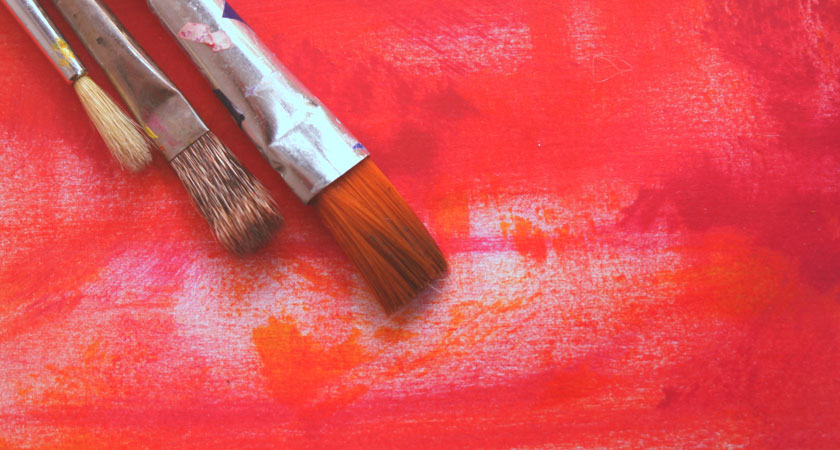
- Paint
You will need paint!
 I recommend starting with the Winsor & Newton Artisan series. This is a water mixable oil paint that performs and dries just as regular oil paint does. However, the difference is a slight change in the molecular structure of the paint that makes it water soluble. What this means for you is that you do not need to purchase or use turpentine or other toxic solvents and paint thinners. Water will do the trick! This also makes cleanup a lot easier, and cuts out the toxic fumes that are often associated with oil painting. (Especially if you are working form a small space like a bedroom or apartment). Win-Win! It may be easiest to buy a set of paint when you are first starting. You could also save money by buying essential colors (e.g., Cadmium Red, Ultramarine Blue, and Cadmium Yellow) and mixing the rest of the colors you will use.
I recommend starting with the Winsor & Newton Artisan series. This is a water mixable oil paint that performs and dries just as regular oil paint does. However, the difference is a slight change in the molecular structure of the paint that makes it water soluble. What this means for you is that you do not need to purchase or use turpentine or other toxic solvents and paint thinners. Water will do the trick! This also makes cleanup a lot easier, and cuts out the toxic fumes that are often associated with oil painting. (Especially if you are working form a small space like a bedroom or apartment). Win-Win! It may be easiest to buy a set of paint when you are first starting. You could also save money by buying essential colors (e.g., Cadmium Red, Ultramarine Blue, and Cadmium Yellow) and mixing the rest of the colors you will use.
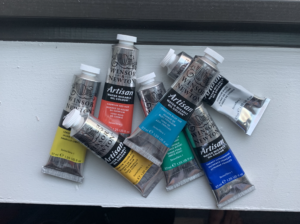
- Brushes, jars, and soap
You do not need expensive brushes for your first time oil painting. Don’t worry about researching specific brush types and what they are each used for. I recommend starting with a basic brush starter set. You can also go the route of purchasing a few individual brushes (round, flat, and fan brushes) in different sizes. Once you begin painting more, you will learn what you enjoy using and how they feel on a canvas. You will also need a jar, preferably glass, and a bar of soap for washing your brushes. The jar I used here was a recycled pasta sauce jar, and the soap is a bar of dove soap I had lying around. No need for anything fancy! I recommend having at least two jars: one to rinse off light paints and one for dark. Some artists find it useful to have a coil at the bottom of a jar, to wipe off the paint on the brush without dipping the brush back into accumulated paint on the bottom of a jar.
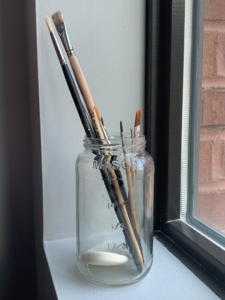
- Medium
Mediums are used to thin out the oil paint and make it more workable. Linseed oil is a great oil medium to start out using, as it will thin out your paint without losing any texture. Think of using linseed oil as you would use water to thin out acrylic or watercolor paint. If you are using water soluble oil paints, you can also use a slight bit of water to thin out your oil paints. It is also important to keep in mind the rules of painting with oils (e.g., fat over lean). Using linseed oil will lead to a “less fatty” paint than using the oil paint alone, meaning that it can be used underneath heavier layers. It is also important to remember that most oil mediums will slow the drying time of the paint.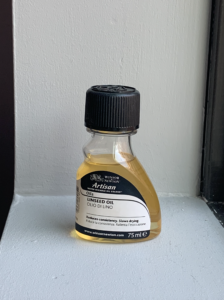
- Palette and paper towels
Whether you are just starting out or an advanced painter, you do not empty your pockets to buy a palette! A glass palette is preferable. However, you can get creative. I have used picture frame glass panels and glass plates for my palettes, both of which can be purchased at the dollar store. Make sure you have a large enough palette for your painting, at least a third the size of your canvas. Also, make sure that you have a paper towel (or any other rag or towel) to wipe your brushes on as you paint.
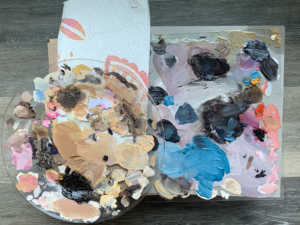
- Something to paint on
Most artists choose to paint on a canvas. Many art stores and online shops sell canvases and canvas boards. It is not important to purchase the most expensive canvas you can find for your first time painting. Consider finding a smaller canvas or canvas board when you are first beginning, so you have enough space to explore the new medium but you will not get overwhelmed with the size of the surface.
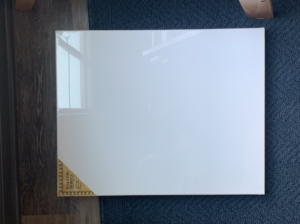
- Easel (optional)
You can get creative without using an easel (I have definitely done this in the past). However, if you feel you are ready to splurge on an easel, it will elevate your studio and make painting a lot easier. This will also allow you to stand back and view your painting from a distance. I recommend a basic H-frame or convertible easel for beginners.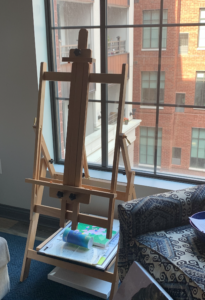
- Painting clothes
Finally, make sure that you wear an apron or clothes you won’t mind getting dirty! After all, painting should be a fun (and sometimes messy) process. Don’t be afraid to let loose and get creative with your artwork. Enjoy the process!

love love love your work!!
Thanks so much!
I love your work! Its absolutely amazing!
Thanks for your kind words!